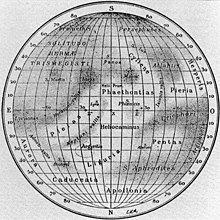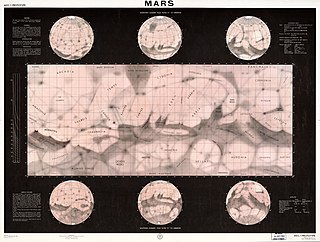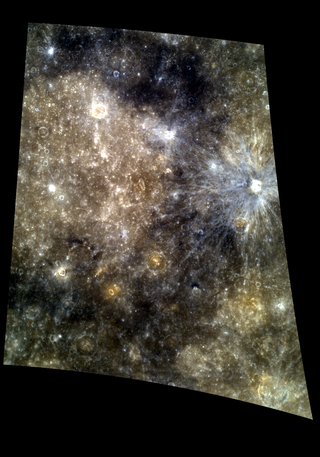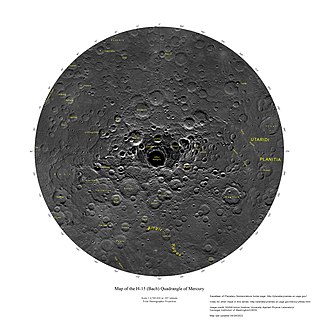| Name | Pronunciation | Location | Meaning of name |
|---|
| Admeti Vallis | | Dark area in the NE quadrant, between Aurora and Pleias | "valley of Admetus" |
| Apollonia | | Light area near the north pole | "land of Apollo" |
| Argyritis | | Light area in the NE quadrant, about 30° N | "silver-bearing land" |
| Aurora | | Light area, 20-30° N, near the eastern terminator | Aurora, the Roman goddess of dawn |
| Caduceata | | Light area in the NE quadrant, north of 50° N | "possessing the caduceus" |
| Cyllene | | Light area in the SW quadrant, extending from about 20° to 50° S | Cyllene, birthplace of Hermes |
| Helii Promontorium | | A feature close to the zero meridian, about 20° S | Means "cape of Helios" |
| Heliocaminus | | Light region in the northern hemisphere, between Phaëthontias and Liguria | "chamber exposed to the sun"; the region is close to the (assumed) sub-solar point |
| Hesperis | | Light region in the SW quadrant, between 10° and 40° S, near the western terminator | "one of the Hesperides" |
| Horarum Vallis | | Dark narrow area in the eastern hemisphere, crossing the Equator SE of Pleias | "valley of the Hours" |
| Ixionis Vallis | | Band connecting Solitudo Atlantis and Solitudo Criophori, in SW quadrant between the Equator and 30° S | "valley of Ixion" |
| Liguria | | Light area in the southern hemisphere, centered slightly west of the zero meridian, at about 40° N | Liguria, a region of Italy |
| Neptuni Vallis | | Dark narrow area in the NE quadrant, NW of Pleias | "valley of Neptune" |
| Pentas | | Light region in the NW quadrant, between the solitudines of Criophori and Aphrodites, extending between about 10° and 40° N | |
| Phaëthontias | | Light region in the southern hemisphere, between Pleias and Pieria | "land of Phaëthon" |
| Pieria | | Light region in the SW quadrant, bordering on Hesperis, between the solitudines of Atlantis and Criophori | Pieria, a region of Greece |
| Pleias | or | Light region in the eastern hemisphere, running across the Equator from SW to NE | "one of the Pleiades" |
| Solitudo Alarum | | Small dark region in the NW quadrant, E of Pentas | "desert of wings", associated with Mercury in his role as swift messenger |
| Solitudo Aphrodites | | Dark region in the NW quadrant, between 30° and 60° N | "desert of Aphrodite" |
| Solitudo Argiphontae | | Dark region in the NW quadrant, extending along the terminator from the Equator to about 60° N | "desert of Argiphontes"; Argiphontes means "slayer of Argus Panoptes" and is an epithet for Hermes |
| Solitudo Atlantis | | Dark region in the SW quadrant, between 20° and 50° S | "desert of Atlas" |
| Solitudo Criophori | | Dark region mostly in the NW quadrant, near the Equator, extending from about 20° N to the western terminator near the Equator | "desert of Criophorus"; Criophorus means "bearer of the ram" and is an epithet for Hermes |
| Solitudo Dionysi | | Dark region in the NE quadrant, between Caduceata and Liguria, about 40° S | "desert of Dionysus" |
| Solitudo Hermae Trismegisti | | Large medium-albedo region in the SE quadrant, between 30° and 60° S | "desert of Thrice-greatest Hermes" |
| Solitudo Iovis | | Dark region in the SE quadrant, centered about 25° S, 20° E | "desert of Jupiter" |
| Solitudo Ius | | Dark patch SE of Solitudo Atlantis, in SW quadrant about 50° S | "desert of Io" |
| Solitudo Lycaonis | | Dark patch near the eastern terminator, centered slightly north of the Equator | "desert of Lycaon" |
| Solitudo Lyrae | | Small dark patch in the SE quadrant, just south of the Equator, adjoining Neptuni Vallis | "desert of the lyre", an instrument associated with Hermes |
| Solitudo Maiae | | Dark region in the SW quadrant, NE of Cyllene | "desert of Maia" (the mother of Hermes) |
| Solitudo Martis | | Dark region in the SE quadrant, about 30°S, 60° E | "desert of Mars" |
| Solitudo Panos | | Dark region in the southern hemisphere, along the zero meridian between 30° and 50° S | "desert of Pan" |
| Solitudo Persephones | | Dark region in the SW quadrant, above 60° S, near the terminator | "desert of Persephone" |
| Solitudo Phoenicis | | Small dark region on the Equator, between 10° and 30° W | "desert of the phoenix" |
| Solitudo Promethei | | Dark region in the SE quadrant, about 70° S, near the eastern terminator | "desert of Prometheus" |















